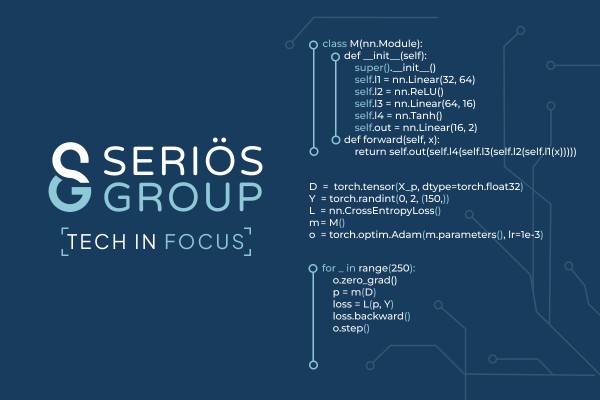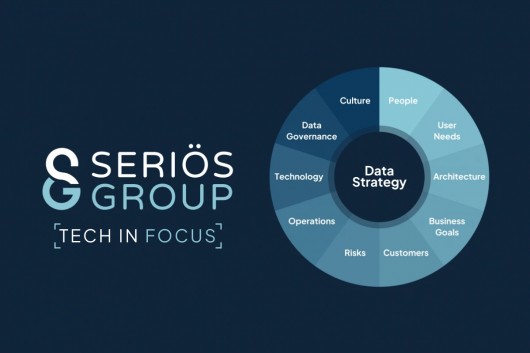Insights
How to Get Your Business AI Ready

- Category
- Blog
- Date published
- 20.08.2025
- Written by
- Adam Brown, Head of Data Strategy and Architecture at Seriös Group
AI Ready. What Does It Really Mean?
1. AI Strategy
AI shouldn’t be treated as a side project or unexpected add-on. It must be part of strategic planning from the outset. That begins with a data strategy that explicitly includes AI, aligns with business goals, and has leadership commitment.
Define a clear but flexible AI strategy. Start small, stay adaptable, and focus on near-term opportunities. The vision doesn’t have to be perfect, it just needs to set direction. Communicating this early helps teams understand AI’s role and ensures initiatives are proactive, not reactive.
2. Data Governance
Before any AI work begins, you need a strong foundation of data governance. This means clear roles, responsibilities, and processes to manage data quality, privacy, and compliance.
Good governance ensures your data is accurate, consistent, and trustworthy, because poor data leads to poor AI outcomes. It also means having policies in place for ethical use, bias mitigation, transparency, and legal obligations like GDPR. These frameworks build trust and provide guardrails for responsible innovation.
3. Understand Your Data Landscape
To make AI effective, you need a detailed understanding of your data landscape. What data do you have, where is it stored, how is it accessed and in what format; structured, semi-structured, or unstructured? Is it real-time or batch?
Many modern AI services rely on streaming data, so it’s vital to understand your systems’ data flow capabilities. A well-maintained data dictionary capturing metadata such as ownership, structure, update frequency and sensitivity plays a key role in helping teams manage and govern data confidently.
4. Understand the AI Landscape
Knowing your data is only half the equation. You also need to understand the AI tools and services available to you. Explore what’s possible with pre-built models, APIs, and low-code platforms. Look at how similar organisations, especially competitors, are using AI to improve operations, enhance customer experiences, or launch new services. These examples help set realistic ambitions and highlight gaps in your own strategy.
5. Get People Engaged
AI success depends on people. Engage teams across the business to uncover real challenges where AI could make a difference. Focus on practical use cases that align with strategic goals.
A strong starting point would be to create a secure, internal version of ChatGPT tailored to your organisation’s knowledge and workflows. This can increase productivity by enabling people to query policies, summarise documents, or retrieve insights, without exposing sensitive data to external tools. A targeted proof of concept like this builds confidence and demonstrates tangible value.
6. Assess Your Data Architecture
Assessing your current architecture is another essential step. Start with a clear picture of your “as-is” state; covering data platforms, integrations, resources and access to AI tools. Then define your “to-be” state: what needs to evolve to support scalable, efficient AI across the business? This could mean shifting to cloud-native services, improving data pipelines, or introducing new security controls.
A structured gap analysis provides a roadmap to ensure your AI ambitions are supported, not constrained, by your infrastructure.
7. Space for Creativity
Creating a dedicated AI test and R&D environment gives teams space to experiment without the pressure of immediate delivery. Allowing time to “play” with models, tools and use cases encourages creativity and helps uncover opportunities you may not have predicted. It also builds internal confidence, laying the foundation for more structured innovation.
8. Assess Your Internal Skills
It’s important to assess your internal skills, and identify what expertise you already have, in data engineering, machine learning, governance, and where there are gaps. Some areas may require targeted upskilling; others might benefit from short-term third-party support. The goal is to create a balanced mix of internal capability and external guidance so you can scale with confidence while reducing your dependency over time.
9. Bringing AI into Everyday Delivery
Becoming AI ready isn’t a one-off project, it’s a strategic shift that must form how your organisation operates. Once the foundations are in place, the next step is to integrate AI into your iterative development cycles. This means incorporating AI into existing governance, change control and planning processes. Keep reviewing and refining your policies, infrastructure and capabilities.
As you grow in confidence, expand your horizons, build reusable solutions, explore new technologies and encourage responsible experimentation. Communicate regularly, share wins and continue investing in skills. In this way, AI shifts from being an isolated initiative to an embedded capability that delivers measurable value, time and again.
10. Build AI on a Solid Data Foundation
AI is only as strong as the data it’s built on. From governance and architecture to skills and strategy, data is the foundation that enables AI to deliver real, repeatable value.
At Seriös Group, we work with organisations to build their data foundations and capabilities needed for scalable AI adoption. Whether you're just starting out or looking to accelerate your AI journey, we can support you.





